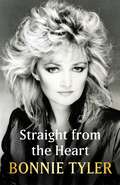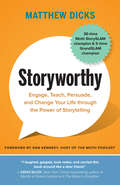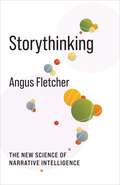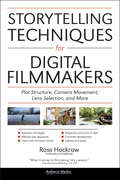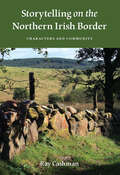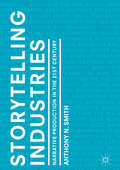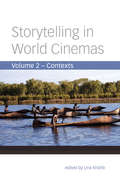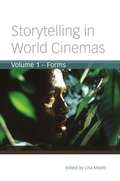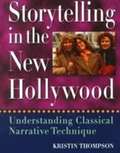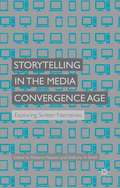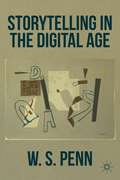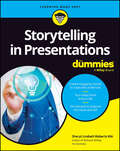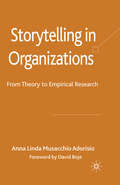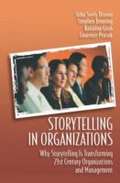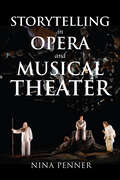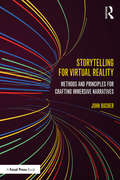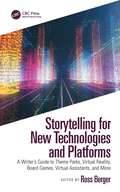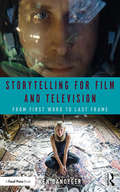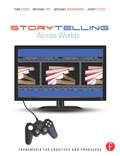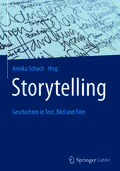- Table View
- List View
Straight from the Heart: BONNIE TYLER'S LONG-AWAITED AUTOBIOGRAPHY
by Bonnie TylerYou know the name and you can't mistake the voice. Now you can read the incredible story of how a shy, music-loving teenager called Gaynor Hopkins morphed into legendary international superstar Bonnie Tyler and carved out an extraordinary career that is still going strong to this day.After five decades in the business - during which time she has recorded some of the most iconic songs of all time, travelled the world and performed for royalty and the Pope - Bonnie is sharing her fascinating journey for the first time. And she's not holding back. From her early days growing up in a tiny mining village in South Wales, to her career as a club singer that led to her accidental discovery by a talent scout, the Top of the Pops devotee had no idea she would one day grace the infamous illuminated stage alongside some of her biggest idols. Her rise to fame would sound like a fairy tale if it wasn't all true.Bonnie has always determinedly followed her own path, even when sceptical music execs told her she would fail. Her bravery led to her working with the legendary producer and songwriter Jim Steinman, going on to record the classic power ballads 'Total Eclipse of the Heart' and 'Holding Out for a Hero', as well as duetting with some of the best-known names in the business. She is undoubtedly one of the biggest vocal powerhouses of her generation, but her roots remain firmly in her beloved Wales. She is resolutely down to earth, funny and endlessly charming. Whether she's talking about the family she adores or sharing hilarious anecdotes from her many years in the spotlight, Bonnie never fails to entertain.Finally, we get to hear the amazing tale of a woman who has led the way for so many other female artists - and has had a bloody great time doing it. Bonnie's much-anticipated memoir is inspirational, moving and straight from the heart.
Storyworthy: Engage, Teach, Persuade, and Change Your Life through the Power of Storytelling
by Matthew Dicks Dan KennedyA five-time Moth GrandSLAM winner and bestselling novelist shows how to tell a great story — and why doing so matters. Whether we realize it or not, we are always telling stories. On a first date or job interview, at a sales presentation or therapy appointment, with family or friends, we are constantly narrating events and interpreting emotions and actions. In this compelling book, storyteller extraordinaire Matthew Dicks presents wonderfully straightforward and engaging tips and techniques for constructing, telling, and polishing stories that will hold the attention of your audience (no matter how big or small). He shows that anyone can learn to be an appealing storyteller, that everyone has something “storyworthy” to express, and, perhaps most important, that the act of creating and telling a tale is a powerful way of understanding and enhancing your own life.
Storythinking: The New Science of Narrative Intelligence (No Limits)
by Angus FletcherEvery time we think ahead, we are crafting a story. Every daily plan—and every political vision, social movement, scientific hypothesis, business proposal, and technological breakthrough—starts with “what if?” Linking causes to effects, considering hypotheticals and counterfactuals, asking how other people will react: these are the essence of narrative. So why do we keep overlooking story’s importance to intelligence in favor of logic?This book explains how and why our brains think in stories. Angus Fletcher, an expert in neuroscientific approaches to narrative, identifies this capacity as “storythinking.” He demonstrates that storythinking is fundamental to what makes us human. Artificial intelligence can perform symbolic logic, rational deduction, and mathematical calculation, but it is incapable of deliberating in narrative. Drawing on new research in neuroscience and narrative theory, Fletcher explores the nature of imagination, innovation, and creativity. He provides concise answers to big questions: How does storythinking work? Why did it evolve? How can it misfire? What problems can it solve?Revealing the significance of storythinking from science to business to philosophy, this book also provides ways for readers to harness its power to script better tomorrows.
Storytelling Techniques for Digital Filmmakers
by Ross HockrowThe key elements of creating an effective film narrative--which involves a significant shift in mindset from still photography to motion capture--are detailed in this guide to becoming a standout digital videographer. Through teaching classic cinematic techniques for storytelling while addressing contemporary digital equipment and customer standards, the guide instructs such elements of filming as mixing the types of shots used, charting the plot, and introducing characters. Equipment use is also explored through the analysis of gear for camera movement and how to create ideal lighting. With a focus on high-definition filming, the book also provides invaluable information on obtaining high-quality audio and how to make the most of video editing.
Storytelling on the Northern Irish Border: Characters And Community
by Ray CashmanMore than quaint local color, folklore is a crucial part of life in Aghyaran, a mixed Catholic-Protestant border community in Northern Ireland. Neighbors socialize during wakes and ceilis--informal nighttime gatherings--without regard to religious, ethnic, or political affiliation. The witty, sometimes raucous stories swapped on these occasions offer a window into Aghyaran residents' views of self and other in the wake of decades of violent conflict. Through anecdotes about local characters, participants explore the nature of community and identity in ways that transcend Catholic or Protestant sectarian histories. Ray Cashman analyzes local character anecdotes in detail and argues that while politicians may take credit for the peace process in Northern Ireland, no political progress would be possible without ordinary people using shared resources of storytelling and socializing to imagine and maintain community.
Storytelling Industries: Narrative Production in the 21st Century
by Anthony N. SmithThis book shows how the unique characteristics of traditionally differentiated media continue to determine narrative despite the recent digital convergence of media technologies. The author argues that media are now each largely defined by distinctive industrial practices that continue to preserve their identities and condition narrative production. Furthermore, the book demonstrates how a given medium’s variability in institutional and technological contexts influences diverse approaches to storytelling. By connecting US film, television, comic book and video game industries to their popular fictional characters and universes; including Star Wars, Batman, Game of Thrones and Grand Theft Auto; the book identifies how differences in industrial practice between media inform narrative production. This book is a must read for students and scholars interested in transmedia storytelling.
Storytelling in World Cinemas
by Lina KhatibStorytelling in World Cinemas, Vol. 2: Contexts addresses the questions of what and why particular stories are told in films around the world, both in terms of the forms of storytelling used, and of the political, religious, historical, and social contexts informing cinematic storytelling. Drawing on films from all five continents, the book approaches storytelling from a cultural/historical multidisciplinary perspective, focusing on the influence of cultural politics, postcolonialism, women's social and cultural positions, and religious contexts on film stories. Like its sister volume, Storytelling in World Cinemas, Vol. 1: Forms, this book is an innovative addition to the academic study of world cinemas.
Storytelling in World Cinemas: Contexts
by Lina KhatibStorytelling in World Cinemas, Vol. 2: Contexts addresses the questions of what and why particular stories are told in films around the world, both in terms of the forms of storytelling used, and of the political, religious, historical, and social contexts informing cinematic storytelling. Drawing on films from all five continents, the book approaches storytelling from a cultural/historical multidisciplinary perspective, focusing on the influence of cultural politics, postcolonialism, women's social and cultural positions, and religious contexts on film stories. Like its sister volume, Storytelling in World Cinemas, Vol. 1: Forms, this book is an innovative addition to the academic study of world cinemas.
Storytelling in World Cinemas: Forms
by Lina KhatibAn innovative collection of essays that discuss how different cinemas of the world tell stories.
Storytelling in World Cinemas
by Lina KhatibStorytelling in World Cinemas, Vol. 2: Contexts addresses the questions of what and why particular stories are told in films around the world, both in terms of the forms of storytelling used, and of the political, religious, historical, and social contexts informing cinematic storytelling. Drawing on films from all five continents, the book approaches storytelling from a cultural/historical multidisciplinary perspective, focusing on the influence of cultural politics, postcolonialism, women's social and cultural positions, and religious contexts on film stories. Like its sister volume, Storytelling in World Cinemas, Vol. 1: Forms, this book is an innovative addition to the academic study of world cinemas.
Storytelling in World Cinemas: Forms
by Khatib Lina Ed.Storytelling in World Cinemas, Vol. 1: Forms is an innovative collection of essays that discuss how different cinemas of the world tell stories. The book locates European, Asian, African, and Latin American films within their wider cultural and artistic frameworks, showing how storytelling forms in cinema are infused with influences from other artistic, literary, and oral traditions. This volume also reconsiders cinematic storytelling in general, highlighting the hybridity of 'national' forms of storytelling, calling for a rethinking of African cinematic storytelling that goes beyond oral traditions, and addressing films characterised by 'non-narration'. This study is the first in a two-volume project, with the second focusing on the contexts of cinematic storytelling.
Storytelling in the New Hollywood: Understanding Classical Narrative Technique
by Kristin ThompsonKristin Thompson offers the first in-depth analysis of Hollywood's storytelling techniques and how they are used to make complex, easily comprehensible, entertaining films.
Storytelling in the Media Convergence Age
by Roberta Pearson Anthony N. SmithThis collection investigates the relationship between contemporary screen narratives and their varied contexts of production, circulation and reception, exploring storytelling practices across a range of different media and national and institutional sites. While convergence and globalisation blur the boundaries between media and nations, it is still vital to account for the persistent national, medium, institutional and technological specificities that give rise to different narrative forms. The chapters study the ways in which these factors shape events, characters and settings; inform modes of narrative presentation; influence, via paratextual surround, potential interpretations; and accord certain stories more value than others. The authors use case studies drawn from a range of media, from Hollywood franchises to digital comics, and a range of countries, from United States to Japan. In connecting contemporary screen media narratives to their contexts, this book offers a new perspective on recent transformations in screen media culture.
Storytelling in the Digital Age
by W. S. PennThrough a professional story-teller's sometimes humorous commentary on culture and literature from The Odyssey on, Storytelling in the Digital Age suggests that literature is not an artifact to be studied but a living process. Often irreverent, crossing literary and scholarly lines, W. S. Penn aims to discover what literature does for an imaginatively engaged reader. Aimed to amuse, provoke, and propose ideas, this book makes bold new statements about what it means to be human through an interrogation of a variety of stories told and re-told over thousands of years.
Storytelling in Religious Education
by Susan M. ShawPart I. Foundations of storytelling in religious education Part II. Types of story in religious education Part III. Development and storytelling
Storytelling in Presentations For Dummies
by Sheryl Lindsell-RobertsLearn to influence audiences with storyopia: Stories that take them on a journey from what is to what could be: Storytelling in Presentations For Dummies shows you how to develop and deliver a presentation through storytelling, keeping audience interested, and most importantly, making them heroes that take action towards change. You’ll learn how to cull stories from your own experiences, and before you know it, you’ll have more stories than Aesop has fables. You’ll learn about the latest presentation software, so you can integrate visuals into your presentations and avoid the dreaded “Death by PowerPoint.” You’ll also learn how to deal with challenging on-the-spot situations, deliver investor pitches and executive briefs, and present a paper at a conference. Additionally, find out how to deliver someone else’s content and make it your own. This book will help you level up anywhere you need to present information by mastering the art of savvy presentations—the most effective business communications tools of our time. Identify experiences that can be molded into stories that drive change. Prepare powerful openings to hook your audience right away whether delivering in person, online, or hybrid Have your audience get the most from your presentation with an effective call to action Prepare a storyboard, which is like a frame-by-frame roadmap, that will mesh together what you’ll show and what you’ll tell Leverage software like Canva, Prezi, and Storyboarder to tie your presentation together Enjoy the colorful 8-page mini-booklet, “Storytelling to Storyboarding”This Dummies guide is perfect for any professional who needs to present, and at some time all professionals do. It’s also for entrepreneurs who want to build community and grow their business, in addition to students who want to wow teachers and classmates.
Storytelling in Participatory Arts with Young People: The Gaps in the Story (Palgrave Studies In Play, Performance, Learning, and Development)
by Catherine HeinemeyerThis book draws on the author’s experience as a storyteller, drama practitioner and researcher, to articulate an emerging dialogic approach to storytelling in participatory arts, educational, mental health, youth theatre, and youth work contexts. It argues that oral storytelling offers a rich and much-needed channel for intergenerational dialogue with young people.The book keeps theory firmly tethered to practice. Section 1, ‘Storyknowing’, traces the history of oral storytelling practice with adolescents across diverse contexts, and brings into clear focus the particular nature of the storytelling exchange and narrative knowledge. Section 2, ‘Telling Stories’, introduces readers to some of the key challenges and possibilities of dialogic storytelling by reflecting on stories from the author’s own arts-based practice research with adolescents, illustrating these with young people’s artistic responses to stories. Finally, section 3, ‘Story Gaps’, conceptualises dialogic storytelling by exploring three different ‘gaps’: the gap between storyteller and listener, the gaps in the story, and the gaps which storytellers can open up within institutions. The book includes chapters taking a special focus on storytelling in schools and in mental health settings, as well as guided reflections for readers to relate the issues raised to their own practice.
Storytelling in Organizations
by Anna Linda Musacchio AdorisioStorytelling in organizations is a notion that encompasses both the stories that the organization produces and the ones told by its members. It provides both an in-depth treatment of the literature on narratives, stories and storytelling and an extensive empirical case from an American banking institution.
Storytelling in Organizations: Why Storytelling Is Transforming 21st Century Organizations and Management
by John Seely Brown Stephen Denning Katalina Groh Laurence Prusak"Storytelling in Organizations" studies how four busy executives found themselves using storytelling to understanding and managing organizations. The authors describe their own experiences working on knowledge management, change management, and innovation strategies in such organizations as Xerox, the World Bank, and IBM.
Storytelling in Opera and Musical Theater (Musical Meaning and Interpretation)
by Nina PennerStorytelling in Opera and Musical Theater is the first systematic exploration of how sung forms of drama tell stories. Through examples from opera's origins to contemporary musicals, Nina Penner examines the roles of character-narrators and how they differ from those in literary and cinematic works, how music can orient spectators to characters' points of view, how being privy to characters' inner thoughts and feelings may evoke feelings of sympathy or empathy, and how performers' choices affect not only who is telling the story but what story is being told. Unique about Penner's approach is her engagement with current work in analytic philosophy. Her study reveals not only the resources this philosophical tradition can bring to musicology but those which musicology can bring to philosophy, challenging and refining accounts of narrative, point of view, and the work-performance relationship within both disciplines. She also considers practical problems singers and directors confront on a daily basis, such as what to do about Wagner's Jewish caricatures and the racism of Orientalist operas. More generally, Penner reflects on how centuries-old works remain meaningful to contemporary audiences and have the power to attract new, more diverse audiences to opera and musical theater. By exploring how practitioners past and present have addressed these issues, Storytelling in Opera and Musical Theater offers suggestions for how opera and musical theater can continue to entertain and enrich the lives of 21st-century audiences.
Storytelling for Virtual Reality: Methods and Principles for Crafting Immersive Narratives
by John BucherStorytelling for Virtual Reality serves as a bridge between students of new media and professionals working between the emerging world of VR technology and the art form of classical storytelling. Rather than examining purely the technical, the text focuses on the narrative and how stories can best be structured, created, and then told in virtual immersive spaces. Author John Bucher examines the timeless principles of storytelling and how they are being applied, transformed, and transcended in Virtual Reality. Interviews, conversations, and case studies with both pioneers and innovators in VR storytelling are featured, including industry leaders at LucasFilm, 20th Century Fox, Oculus, Insomniac Games, and Google. For more information about story, Virtual Reality, this book, and its author, please visit StorytellingforVR.com
Storytelling for New Technologies and Platforms: A Writer’s Guide to Theme Parks, Virtual Reality, Board Games, Virtual Assistants, and More
by Ross BergerWant to know what it’s like to write for a theme park attraction? Or an interactive toy? Or for a virtual reality game? Wait – those tell stories? And there are jobs for people to write them? Thanks to technology, interactive products and live experiences can now engage us with memorable characters and exciting adventures that were once only destined for the cinema. Storytelling for New Technologies and Platforms: A Writer’s Guide to Theme Parks, Virtual Reality, Board Games, Virtual Assistants, and More is a handbook for writers, students, producers, teachers, scholars, career changers, early tech adopters, and just about anyone who loves story and technology. As a collection of articles from some of the best creative writers in their medium, this book will prepare content creators of tomorrow to tackle some of today's most exhilarating creative challenges found on a screen ... or off! Key Features: Expert advice from several industry professionals who have worked for some of the world’s biggest tech and interactive companies. Best practices that not only guide writers on how to apply their craft to new fields, but also prepare them for the common ambiguity they will find in corporate and start-up environments. Breakdown of platforms that shows how tech capabilities can fulfill content expectations and how content can fulfill tech expectations. Basic storytelling mechanics customized to today’s popular technologies, live experiences, and traditional game platforms.
Storytelling for Film and Television: From First Word to Last Frame
by Ken DancygerStorytelling for Film and Television is a theory and practice book which offers a definitive introduction to the art of storytelling through writing, directing, and editing. Author Ken Dancyger provides a comprehensive explanation of the tools that underpin successful narrative filmmaking and television production. The book takes a unique approach by connecting the different phases of the creative process of film and television production. It shows how writing, directing, and editing all contribute to the process of storytelling and function together to advance the narrative goals of a screenplay, to tell the best story. A case study approach provides numerous examples of effectiveness and brings together the core areas of aesthetics and production to make these concepts more accessible. Case studies include classic and modern films, foreign films, limited and series television, with examples including Breaking Bad, Game of Thrones, The Revenant, and Son of Saul. This is the ideal text for film and television production students at all levels. It is written in a style which makes it accessible to anybody interested in learning more about the storytelling process and is written for a global audience addressing a global industry.
Storytelling Across Worlds: Transmedia for Creatives and Producers
by Tom DowdDon’t restrict your creative property to one media channel. Make the essential leap to transmedia! From film to television to games and beyond, Storytelling Across Worlds gives you the tools to weave a narrative universe across multiple platforms and meet the insatiable demand of today’s audience for its favorite creative property. This, the first primer in the field for both producers and writers, teaches you how to: * Employ film, television, games, novels, comics, and the web to build rich and immersive transmedia narratives * Create writing and production bibles for transmedia property * Monetize your stories across separate media channels * Manage transmedia brands, marketing, and rights * Work effectively with writers and producers in different areas of production * Engage audiences with transmedia storytelling Up-to-date examples of current transmedia and cross-media properties accompany each chapter and highlight this hot but sure-to-be enduring topic in modern media.
Storytelling
by Annika SchachDas Buch pr#65533;sentiert eine textlinguistische Analyse von Texten zur Unternehmensgeschichte und widmet sich dem vielzitierten Storytelling-Trend. Anhand von Textexemplaren der DAX30-Unternehmen werden die Textfunktion, Themenentfaltung und Formulierungsspezifika untersucht. Ein besonderer Schwerpunkt liegt in der Fragestellung, inwieweit Narration als Vertextungsstrategie verwendet wird und wie sich die Textexemplare in einer Typologie beschreiben lassen. Die Arbeit stellt zudem einen Bezug zum medienwissenschaftlichen Framing-Ansatz her.
